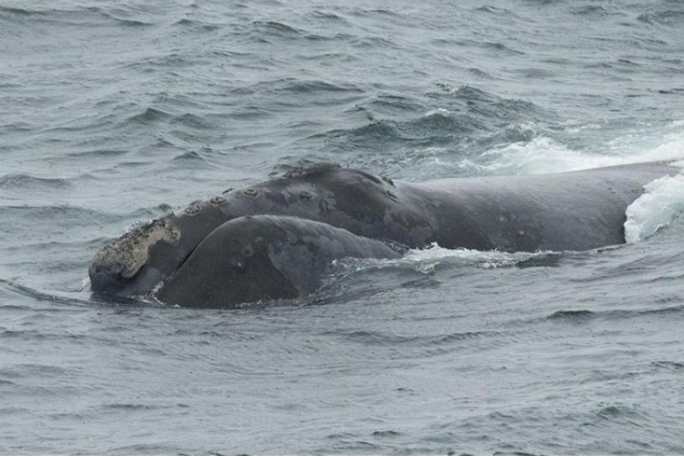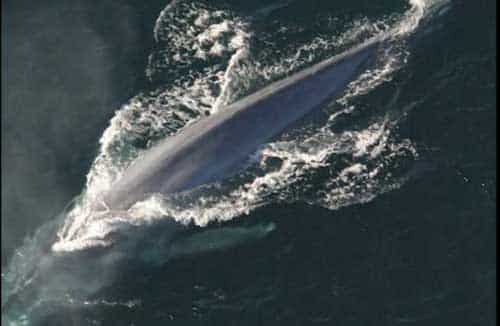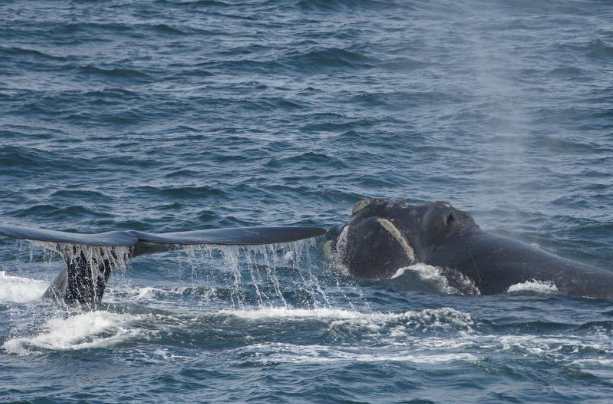 Eastern North Pacific Right whale MML# 84 “Cuatro” (female) in the Bering Sea in August 2017. Credit: K. Matsuoka/International Whaling Commission and NOAA Fisheries
Eastern North Pacific Right whale MML# 84 “Cuatro” (female) in the Bering Sea in August 2017. Credit: K. Matsuoka/International Whaling Commission and NOAA FisheriesEastern North Pacific right whales once numbered in the tens of thousands; today there are estimated to be fewer than 50. Studying these extremely rare whales across their vast ocean range is an enormous challenge. Much information that is crucial for their protection and recovery remains unknown.
“With a population of fewer than 50 individuals, the eastern North Pacific right whale is the most endangered large whale population in the world,” said Amy Kennedy, NOAA Fisheries Affiliate/University of Washington. “We know almost nothing about them. We need to collect as much information as we can to better understand this stock.”
A new NOAA Fisheries study compiled all sightings of eastern North Pacific right whales since 2006 to expand our knowledge of their movements and habitat. It included both survey and opportunistic sightings—from fishermen, whale watchers, and other sources. It analyzed information on feeding and other behavior. The study reveals that sightings in the whales’ northern range (northern Bering Sea) have increased since 2006. However, it remains unclear whether these changes reflect changes in whale population size or habitat use, or if greater survey effort and public awareness led to more reports.
“This study brings all recent eastern North Pacific right whale sighting information into one place,” said Jessica Crance, NOAA Fisheries Alaska Fisheries Science Center, who co-led the study with Kennedy. “I think the most exciting finding is that we’re getting more reports of opportunistic sightings. That gives me hope that there is growing public awareness of this population.”
A Mysterious Whale
Historically, tens of thousands of North Pacific right whales roamed the entire North Pacific Ocean. Intensive commercial whaling in the 1800s, followed by illegal captures in the mid-20th century virtually decimated the species.
North Pacific right whales comprise two genetically and behaviorally separate populations: eastern and western. The western population is found in Asia waters, from the Sea of Okhotsk down to Japan, while the eastern population ranges from Alaska down the west coast of North America to Mexico and Hawai’i. Studies suggest that the western population numbers are in the low hundreds. Fewer than 50 individuals are estimated to remain of the eastern population.
Despite their endangered status, there have been few dedicated surveys of the eastern North Pacific population. As a result, many aspects of their lives remain a mystery, including:
- Migratory routes
- Calving grounds
- Important habitat
- Life history (individual growth, reproduction, and lifespan)
- Population demography (age, sex, reproduction, and mortality)
Surveys and Opportunistic Sightings
Until now, sighting records had not been published since 2005, when the analysis for critical habitat designation was conducted. That compilation (1970–2005) largely included sightings made during dedicated surveys. The new study brings together all contemporary sightings of eastern North Pacific right whales from 2006 to 2023, including sightings from:
- Dedicated eastern North Pacific right whale surveys
- Opportunistic sightings during surveys of other marine mammals
- Reports from fishermen, recreational boaters, ecotourists, whale watch operators, and the NOAA Platforms of Opportunity Program
“Opportunistic reports can expand our knowledge of potentially important habitat and point us to new areas that we need to survey,” Kennedy said. “But we also need dedicated surveys to collect biopsies, high-quality photos, feeding information, and to tag animals. We can gather a lot of information in a relatively short amount of time during a dedicated ship survey.”
The last dedicated eastern North Pacific right whale surveys were in 2010 (Bering Sea) and 2015 (Gulf of Alaska). All sightings since then were made during other marine mammal surveys or were opportunistic reports from other sources.
Researchers compared new sightings with known individuals recorded in the NOAA Fisheries Alaska Fisheries Science Center Marine Mammal Laboratory catalog.
“If we can match a new sighting with an animal in the catalog, that tells us a lot,” Kennedy said. “It gives us clues to migration routes. We can get a glimpse of a whale’s life history.”
Increased Sightings Provide New Information—and Hope
Knowing migration routes, breeding grounds, important habitat, and population demographics is essential for effective management and conservation efforts.
“While most of these remain unknown for eastern North Pacific right whales, the increased sightings in recent years have helped fill in some of those knowledge gaps,” Crance said.
In the past 18 years, 99 sightings have been reported compared to only 74 during the previous 35 years. It is unclear whether the increase in reports is due to an increase in survey effort, public awareness, or whether it truly reflects a growing whale population. Either way, the increased number of sightings provides new information—and new hope—for eastern North Pacific right whales.
“We’re seeing a lot more opportunistic sightings reported. It means we’re getting the message out. People know it’s a special animal,” Kennedy said. ”We’ve identified a number of new animals and we’ve gotten photographic matches from opportunistic sightings.”
“We continue to add new animals to the catalog and resight individuals. The whales we see are healthy and robust. And they still have a surprising amount of genetic diversity,” said Crance. “It shows there is still hope. The population is small, but it is resilient.”
The combined sightings provide new insight into the whales’ distribution and movement:
- Sightings in the northern Bering Sea, Gulf of Alaska, and along the west coast of North America have increased.
- There have been no sightings of right whales in Hawai’i or Mexico since 1996, and no sightings in the central or eastern North Pacific off the continental shelf since the 1970s.
- Feeding has been observed throughout their range, suggesting right whales will opportunistically feed whenever possible.
- All sightings off the coast of California were during February–May.
- Sightings off the coast of British Columbia were in May–July or in October.
- There was one long-distance resighting between British Columbia and the Gulf of Alaska in 2021.
- There has never been a sighting in Alaska in January.
- There has never been a match between the Bering Sea and Gulf of Alaska.
Crance says the timing of the California and British Columbia sightings suggests a possible migratory route. “But we can’t say with certainty, since none of the photos have been rematched to a different location.”
In the last 50 years, there has only been one migratory match, in which an animal seen in Hawai’i in 1996 was resighted in the Bering Sea only 3 months later. This 1996 sighting was the last sighting of an eastern North Pacific right whale in Hawaiian waters. However, in 2021, an animal (MML# 103) was first sighted off British Columbia in June and was resighted two months later in August in the Gulf of Alaska.
While the primary migratory destination of eastern North Pacific right whales remains unknown, the recent sightings have provided insight into important habitat in Alaska.
The research highlights the need for dedicated eastern North Pacific right whale surveys, particularly in areas that haven’t been surveyed in the past.
“Collating these sightings helps point us to where and when these surveys should take place,” Crance said. “For example, all California sightings were in spring. That tells us we should be surveying for right whales then.”
The study also underscores the importance of opportunistic sightings.
“There are a lot of boats out on the water—fishermen, recreational boaters, whale watchers. If they can be our eyes on the water, it really matters,” Kennedy said. “We want all of your photos. If you can do so from a safe distance (500 yards at minimum), take lots of pictures from all sides. If you send us photos of a right whale, especially if you get the white patches on its head, it will be matched or get a new name.”
“This isn’t just an Alaska species—their range spans five states and three countries. They can occur anywhere in the North Pacific. Keep an eye out for them,” Crance said. “If you happen to see a right whale, reach out and let us know at NP.RW@noaa.gov.”
[content id=”79272″]













